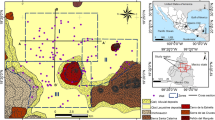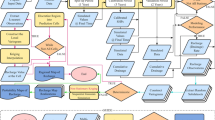Abstract
In previous studies, the groundwater flow models formulated for the Hat Yai Basin were conventional and deterministic because the geologic heterogeneity of the alluvial aquifer system in the basin had not yet been assessed. This paper describes an effort to develop hydrofacies models, such that the spatial variability of the aquifer system can be represented in a systematic way. Variogram parameters that characterize the alluvial aquifer heterogeneity were determined. Based on these variogram parameters, an indicator-based geostatistical approach was used to develop hydrofacies models using sequential indicator simulation. The hydrofacies models indicate three distinct aquifer units, namely Hat Yai, Khu Tao, and Kho Hong aquifers, which is in good agreement with a conceptual model, and incorporates spatial variability as observed in field data from borehole logs. The hydrofacies models can be used in groundwater modeling and simulations.
Similar content being viewed by others
References
Almeida JA (2010) Stochastic simulation methods for characterization of lithoclasses in carbonate reservoirs. Earth Sci Rev 101:250–270. doi:10.1016/j.earscirev.2010.05.002
Cabello P, Cuevas JL, Ramos E (2007) 3D modelling of grain size distribution in Quaternary deltaic deposits (Llobregat Delta, NE Spain). Geol Acta 5:231–244
Carle SF, Labolle EM, Weissmann GS, Van Brocklin D, Gogg GE (1998) Conditional simulation of hydrofacies architecture: a transition probability/Markov approach. In: Fraser GS, Davis JM (eds) Hydrogeologic models of sedimentary aquifers. Concepts in hydrogeology and environmental geology. SEPM Special Publication, Tulsa, pp 147–170
Carle SF, Esser BK, Moran JE (2006) High-resolution simulation of basin-scale nitrate transport considering aquifer system heterogeneity. Geosphere 2:195–209. doi:10.1130/GES00032.1
Chalermyanont T, Lukjan A, Arrykul S (2009) Development of a seawater intrusion model for the Hat Yai Basin, Southern Thailand. In: International symposium on efficient groundwater resources management (IGS-TH 2009), Bangkok, Thailand
Cooper HH, Jacob CE (1946) A generalized graphical method for evaluating formation constants and summarizing well field history. Trans Am Geophys Union 24:526–534
de Marsily G, Delay F, Teles V, Schafmeister MT (1998) Some current methods to represent the heterogeneity of natural media in hydrogeology. Hydrogeol J 6:115–130. doi:10.1007/s100400050138
de Marsily G, Delay F, Gonçalves J, Renard P, Teles V, Violette S (2005) Dealing with spatial heterogeneity. Hydrogeol J 13:161–183. doi:10.1007/s10040-004-0432-3
dell’Arciprete D, Bersezio R, Felletti F, Giudici M, Comunian A, Renard P (2012) Comparison of three geostatistical methods for hydrofacies simulation: a test on alluvial sediments. Hydrogeol J 20:299–311. doi:10.1007/s10040-011-0808-0
Department of Groundwater Resources: DGR (2003) Groundwater balance and modeling assessment of Hat Yai basin, Songkhla Province. Final Report (in Thai)
Department of Groundwater Resources: DGR (2006) Development and conservation of groundwater using mathematical models in Songkhla Lake Basin. Final Report (in Thai)
Deutsch CV (1992) Annealing techniques applied to reservoir modeling and the integration of geological and engineering (well test) data. Dissertation, Stanford University
Deutsch CV (1998) Cleaning categorical variable (lithofacies) realizations with maximum a posteriori selection. Comput Geosci 24(6):551–562. doi:10.1016/S0098-3004(98)00016-8
Deutsch CV (2002) Geostatistical reservoir modeling. Oxford University Press, New York
Deutsch CV, Journel AG (1992) GSLIB: geostatistical software library and user’s guide. Oxford University Press, New York
Falivene O, Cabrera L, Muñoz JA, Arbués P, Fernández O, Sáez A (2007) Statistical grid-based facies reconstruction and modeling for sedimentary bodies: alluvial-palustrine and turbiditic examples. Geol Acta 5:199–230
Fogg GE, Noyes CD, Carle SF (1998) Geologically-based model of heterogeneous hydraulic conductivity in an alluvial setting. Hydrogeol J 6:131–143. doi:10.1007/s100400050139
Folk RL (1954) The distinction between grain size and mineral composition in sedimentary rock nomenclature. J Geol 62(4):344–359
Gego EL, Johnson GS, Hankins M (2001) An evaluation of methodologies for the generation of stochastic hydraulic conductivity fields in highly heterogeneous aquifers. Stoch Environ Res Risk Assess 15:47–64. doi:10.1007/s004770000060
Goovaerts P (1996) Stochastic simulation of categorical variables using a classification algorithm and simulated annealing. Math Geol 28(7):909–921. doi:10.1007/BF02066008
Goovaerts P (1997) Geostatistics for natural resources evaluation. Oxford University Press, New York
Guastaldi E, Carloni A, Pappalardo G, Nevini J (2014) Geostatistical methods for lithological aquifer characterization and groundwater flow modeling of the Catania Plain Quaternary aquifer (Italy). J Water Resour Protect 6:272–296. doi:10.4236/jwarp.2014.64032
Journel AG, Xu W (1994) Posterior identification of histograms conditional to local data. Math Geol 26:323–359. doi:10.1007/BF02089228
Journel AG, Gundeso R, Gringarten E, Yao T (1998) Stochastic modelling of a fluvial reservoir: a comparative review of algorithms. J Pet Sci Eng 21:95–121. doi:10.1016/S0920-4105(98)00044-8
Lohawijarn W (2005) Potential ground water resources of Hat Yai basin in peninsular Thailand by gravity study. Songklanakarin J Sci Technol 27(3):633–647
Lukjan A (2009) Study of seawater intrusion into aquifers in Hat Yai basin using a mathematical model. Thesis, Prince of Songkla University (in Thai)
Lukjan A, Chalermyanont T, Arrykul S (2009a) Three-dimensional density-dependent seawater intrusion modeling for the Hat Yai basin. In: Proceeding of 14th national convention on civil engineering, nakhon ratchasima, Thailand, pp 1253–1259 (in Thai)
Lukjan A, Chalermyanont T, Chaipraphat S, Jespatananon P (2009b) Groundwater balance and safe yield in Hat Yai basin, Songkhla province. In: 7th PSU-engineering conference, Songkhla, Thailand, pp 608–613 (in Thai)
Michael HA, Voss CI (2009) Estimation of regional-scale groundwater flow properties in the Bengal basin of India and Bangladesh. Hydrogeol J. doi:10.1007/s10040-009-0443-1
Modis K, Sideri D (2013) Geostatistical simulation of hydrofacies heterogeneity of the West Thessaly aquifer systems in Greece. Nat Resour Res. doi:10.1007/s11053-013-9200-1
Ouellon T, Lefebvre R, Marcotte D, Boutin A, Blais V, Parent M (2008) Hydraulic conductivity heterogeneity of a local deltaic aquifer system from the kriged 3D distribution of hydrofacies from borehole logs, Valcartier, Canada. J Hydrol 351:71–86. doi:10.1016/j.jhydrol.2007.11.040
Phelps GA, Boucher A, Halford KJ (2011) A refined characterization of the alluvial geology of yucca flat and its effect on bulk hydraulic conductivity. U.S. Geological Survey, Open-File Report 2010-1307
Quental P, Almeida JA, Simões M (2012) Construction of high-resolution stochastic geological models and optimal upscaling to a simplified layer-type hydrogeological model. Adv Water Resour 39:18–32. doi:10.1016/j.advwatres.2012.01.001
Ramnarong V, Songsawat S, Sakulkeaw S, Phanjasutharot S (1984) Hydrological map of Hat Yai basin, Songkhla, Scale 1:50000. Groundwater Division, Department of Mineral Resources, Bangkok
Remy N, Boucher A, Wu J (2009) Applied geostatistics with SGeMS: a user’s guide. Cambridge University Press, New York
Renard P, Le Loc’h G, Ledoux E, de Marsily G, Mackay R (2000) A fast algorithm for the estimation of the equivalent hydraulic conductivity of heterogeneous media. Water Resour Res 36:3567–3580. doi:10.1029/2000WR900203
Riyapan N (2012) Groundwater management of Hat Yai basin using a mathematical model. Thesis, Prince of Songkla University (in Thai)
Robertson GP (2008) GS+: geostatistics for the environmental sciences. Gamma Design Software, Plainwell
Sakulkeaw S (1996) Groundwater vicinity Hat Yai basin, Songkhla Province. Department of Groundwater Resources, Bangkok (in Thai)
Sawata H, Wongsomsak S, Tanchotikul A, Dansawasdi R, Maneeprapun K, Muenlek S (1983) A hypothetical idea on the formation of HatYai basin and the Songkhla lagoon. Proceedings of the Annual Technical Meeting, Department of Geological Sciences, Chiang Mai University, pp 109–120
Seifert D, Jensen JL (1999) Using sequential indicator simulation as a tool in reservoir description: issues and uncertainties. Math Geol 31:527–550. doi:10.1023/A:1007563907124
Seifert D, Jensen JL (2000) Object and pixel-based reservoir modeling of a braided fluvial reservoir. Math Geol 32:581–603. doi:10.1023/A:1007562221431
Serrano RP, Guadagnini L, Riva M, Giudici M, Guadagnini A (2014) Impact of two geostatistical hydro-facies simulation strategies on head statistics under non-uniform groundwater flow. J Hydrol 508:343–355. doi:10.1016/j.jhydrol.2013.11.009
Simo AT, Marache A, Lastennet R, Breysse D (2013) Reconstructing hydraulic conductivity field for hydrogeological modeling in an urban environment. Eng Geol 158:119–134. doi:10.1016/j.enggeo.2013.03.013
Soares A (1998) Sequential indicator simulation with correction for local probabilities. Math Geol 30(6):761–765. doi:10.1023/A:1022451504120
Theis CV (1935) The relation between the lowering of the piezometric surface and the rate and duration of discharge of a well using ground-water storage. Trans Am Geophys Union 16:519–524
Todd DK (1959) Ground water hydrology. Chapman & Hall, London, p 336
Trevisani S, Fabbri P (2010) Geostatistical modeling of a heterogeneous site bordering the Venice Lagoon, Italy. Ground Water 48(4):614–623. doi:10.1111/j.1745-6584.2009.00632.x
Troldborg L (2004) The influence of conceptual geological model on the simulation of flow and transport in Quaternary aquifer systems. Dissertation, Geological Survey of Denmark and Greenland Report 2004/107, GEUS, Copenhagen
Troldborg L, Refsgaard JC, Jensen KH, Engesgaard P (2007) The importance of alternative conceptual models for simulation of concentrations in multi-aquifer systems. Hydrogeol J 15:843–860. doi:10.1007/s10040-007-0192-y
Weissmann GS, Fogg GE (1999) Multi-scale alluvial fan heterogeneity modeled with transition probability geostatistics in a sequence stratigraphic framework. J Hydrol 226:48–65. doi:10.1016/S0022-1694(99)00160-2
Weissmann GS, Carle SF, Fogg GE (1999) Three-dimensional hydrofacies modeling based on soil surveys and transition probability geostatistics. Water Resour Res 35:1761–1770. doi:10.1029/1999WR900048
Weissmann GS, Zhang Y, Labolle EM, Fogg GE (2002) Dispersion of groundwater age in an alluvial aquifer system. Water Resour Res 38:1198–1211. doi:10.1029/2001WR000907
Wentworth CK (1922) A scale of grade and class terms for clastic sediments. J Geol 30(5):377–392
Xu W (1995) Stochastic modeling of reservoir lithofacies and petrophysical properties. Dissertation, Stanford University
Acknowledgements
This research was supported partly by the Graduate study fund, Prince of Songkla University (PSU), and by the Rajamangala University of Technology Srivijaya (RMUTSV) fund, which is gratefully acknowledged. The authors would like to thank the Department of Groundwater Resources (DGR) for providing the borehole log data to this analysis. The authors would like to thank Dr. Seppo Karrila for reviewing the manuscript. Thanks are also given to anonymous reviewers for valuable comments.
Author information
Authors and Affiliations
Corresponding author
Rights and permissions
About this article
Cite this article
Lukjan, A., Chalermyanont, T. Assessment of alluvial aquifer heterogeneity and development of stochastic hydrofacies models for the Hat Yai Basin in Southern Thailand. Environ Earth Sci 76, 316 (2017). https://doi.org/10.1007/s12665-017-6637-2
Received:
Accepted:
Published:
DOI: https://doi.org/10.1007/s12665-017-6637-2












